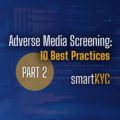This series provides effective tips for ensuring that individuals are able to implement a continuous negative news screening programme despite the possible challenges.
Be sure to read the complete series! Check out Part 1 and Part 2 on our blog.
7. Source authority
Know what sources to trust.
Banks value story veracity so that they don’t act on unreliable or fake news. However, this can lead to individuals relying only on a small pool of ‘trusted’ media sources, for example, a national media outlet. A balance needs to be struck here.
There are many credible, trustworthy online news sites and blogs whose output is only available directly, not via a third party. Many of these have sophisticated news gathering operations and will be particularly attuned to their local market and are often used by other bigger international media outlets as a primary news source.
Waiting for a ‘reputable’ source to report on something can result in latency and lack of audience-relativity. Stories break somewhere and can take a long time to percolate up, especially if it happens in a foreign jurisdiction. Another issue can be that unless the subject is high profile, most stories won’t make it past the desk of that national news outlet. This can be even more likely if the story relates to a foreign national given the domestic agenda of most news outlets.
It is worth rethinking your definition of ‘intelligence’ and its place in KYC monitoring. We can point to an example where the first suggestion of political corruption in a very high profile case was actually made in the comments section of a celebrity gossip site. Such comments are accessible only via search engines but should they be ignored as they lack authority? Should the site be dismissed altogether?
Important to point out that by subscribing to a paid-for media archive you are not only accessing historic content that might not be available elsewhere, but providers can rightfully argue there is source authority by design, given they curate and pay for aggregating news sources.
8. Accentuate the positive
KYC shouldn’t be the exclusive preserve of the compliance function.
Compliance will say that extracting the positives isn’t our responsibility, but the business might need to think about a more holistic approach as looking for positive events and indicators is just the flip side of the same KYC coin.
The business, not necessarily compliance, could be watching for opportunity as well as risk using the same technology, tailored to the needs of the business line – a liquidity event, an asset disposal, a personal event, a specific corporate action and so on.
Such things are understandably far from the minds of financial crime professionals but positioned as part of a broader client lifecycle management play, the monitoring investment argument may be given additional heft and not seen as just another grudge compliance purchase.
9. Joined up thinking
It does not make sense to establish an intelligence baseline at onboarding with one system but monitor that client relationship with another – and this is not just because there will be two discrete systems to learn and support.
Not only will there be different rubrics to how the systems approach their separate tasks, but that factual baseline established at onboarding cannot be used to ensure KYC monitoring noise is kept to a minimum (see Déjà vu in Part 2 of the series.)
A key factor for any KYC implementation is auditability. Any system must record not only what was searched and when but also what actions were taken, who took those actions, what material was regarded as relevant and what was discarded. It’s perhaps not the most exciting aspect of what we do because imagine the alternative: manual logging, errors, a mess of unstructured supporting documentation — all on top of human inconsistency.
Another consideration is how your KYC monitoring system ‘talks’ to your CLM system, which is the one entrusted with the broader orchestration of the various aspects of the client relationship. Potential hits need to be routed correctly, triaged for further investigation, managed according to necessary roles and permissions, outcomes appropriately recorded and maintained between monitoring system and CLM. Your provider needs to have the requisite technology and professional skills to understand these requirements in tedious detail and be able to implement them.
10. Consume media responsibly
There is currently not a license that allows an organization to consume any media content freely in whichever way it chooses. Even if this existed, it may not explain some common practices, such as downloading page after page of material or taking endless screengrabs of results.
From a practical perspective, it does not make sense to guzzle content in varying formats in the interest of due diligence. It is far better to search with a higher degree of precision and generate a consolidated, economical and readily portable dossier that is also consistent, from review to review.
Meeting the ten challenges of implementing an effective high-frequency adverse media screening programme may be a tall order but it promises the ultimate compliance defense – eyes always open. Success requires a combination of precision technology, deep KYC domain knowledge and an ability to navigate the increasingly complex world of mainstream and social media.
Click here to read Part 1 and Part 2 of our Adverse Media Screening Series.
About smartKYC
smartKYC is the world’s most advanced multilingual semantic search engine to machine read all online media content for potential adverse news about your clients, improving KYC processes and reducing risks.
The shortcomings of traditional adverse media screening tools result in inefficiency, frustration and a lack of confidence in the work done. In contrast, smartKYC’s semantic search and media analysis platform results in faster, better and more cost-effective KYC. If you’re interested in learning more about smartKYC’s award-winning technology and how it can transform the efficiency and effectiveness of your KYC operations, book your demo today.
